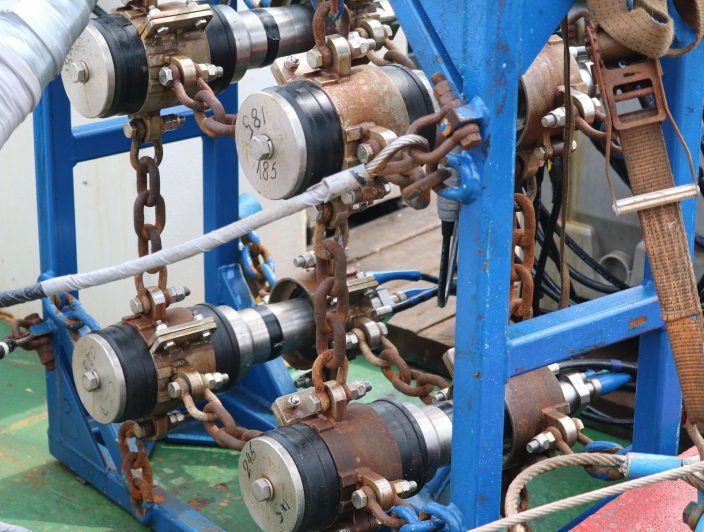IWDG have become concerned recently about apparently unregulated geophysical site investigations being carried out at proposed offshore windfarm sites. Here Patrick Lyne of the IWDG presents our concerns and calls on our licensing authorities to tighten up their procedures and requirements to ensure impacts on marine mammals and their habitats are kept to a minimum, while we embrace international best practice and ensure legal obligations are fulfilled.
Currently at least one offshore windfarm site investigation survey is being carried out inside the 12 mile limit without an approved licence. While none are licenced outside the 12 mile limit.
Foreshore licences have been standard practice for years for geophysical surveys and all oil and gas work in the entire EEZ has been licenced for a long time now.
Noise is a well recognized pollutant and sound from geophysical surveys varies, with sound output ranging upwards from the level of stun grenades to seismic surveys which are louder and these have been shown to cause damage in everything from krill, to scallops, to seagrass and up to whales.
IWDG welcomes the approach by RWE who stated (July 1 2022) in its application for Dublin Array:
“Specific marine survey activities (such as geophysical, geotechnical and certain types of environmental surveys) are only permitted to be undertaken under a Foreshore Licence issued by the Department of Housing, Local Government and Heritage.”.
No Spatial Controls.
Lack of a foreshore licence means there can be no defined area of operations and that shooting can occur in any location. Surveys if they occur in SAC’s are designated as Activities Requiring Consent[1] (ARCs) under ARC 35 “Undertaking active acoustic surveys in the marine environment” and the Minister for Housing and Local Government is required to issue a consent. All surveys in the foreshore will likely impact some SACs and cumulative effects should be assessed.
No Consultation
The absence of any public consultation deprives the rights to the public and NGOs of any say in the environmental process guaranteed under the Aarhus Convention of 1998 and to which the EU and Ireland are signatories.
No Assessment of Risk = non-compliance with guidelines and Article 12 of Habitats Directive.
The lack of assessment of impacts is contrary CMS (2017) COP 12 Resolution to which Ireland and the EU are signatories.
NPWS (2014) [2] guidelines state “An assessment of risk forms an important part of the decision-making framework for mitigating the effects of anthropogenic sound in the marine environment”. Licence or consent conditions are required to be passed to Marine Mammal Observers and application of these guidelines is to be informed by the risk assessment. Yet no risk assessment is performed. Lack of a licence means compliance with the NPWS guidelines is not possible. These guidelines were brought in as a response to the European Court of Justice case on Article 12 of the Habitats Directive (Case C-183/05) against Ireland. Less then full application of the NPWS guidelines means Ireland is once again in contravention of Article 12.
As a core part of its response to obligations to implement Art 12(1) of the Directive to implement a system of strict protection for species, Ireland relies on Species Action Plans, and Threat Response Plans etc.[3] In the case of cetaceans it produced a “Conservation Management Plan for Irish Cetaceans”[4], (known as “The Conservation Plan”). The plan in its preface acknowledges the reason for its production and its role in delivering on strict protection for cetaceans with the following:
“On 11 January 2007 the European Court of Justice ruled that Ireland had failed to fulfil its obligations in relation to inter alia Article 12 of the Habitats Directive (Case C-183/05). This plan was prepared as part of Ireland’s response to this judgement. Its primary purpose is to identify the principal scientific, administrative and regulatory provisions that must be established in a coherent and integrated manner to ensure that strict protection is provided to all cetaceans occurring within the Irish Exclusive Economic Zone.”
It should be recognised that unlicensed surveys are contrary to the NPWS guidelines on noise mitigation, which were developed as part of a response to the ECJ ruling in 2007, and are contrary to the Aarhus Convention (1998) by not allowing public participation, contrary to CMS (2017) in not providing any assessment of risk and the argument such surveys are not touching the seabed while potentially damaging it with sound waves is tenuous at best.
If the courts are required to decide on the correct application of the law, this will regardless of outcome, be very damaging for offshore development, while a strict clear regulatory process leaves less room for legal appeals and a more sure route to development for industry.
The IWDG therefore calls now for all geophysical surveys to be risk assessed, go through a period of consultation and be approved, regulated and enforced by a regulator before being allowed to proceed. There needs to be an understanding of how surveys work, what equipment they are using, where they are allowed to work with temporal restrictions where appropriate. During periods of rapid development the cumulative effects of current surveying needs to be considered appropriately.
This is something the Irish government is legally obliged to do under EU and various international commitments but is also seen as best practice in the development of offshore industry.
[1] https://www.npws.ie/farmers-and-landowners/activities-requiring-consent
[2]https://www.npws.ie/sites/default/files/general/Underwater%20sound%20guidance_Jan%202014.pdf
[3] In case c-183/05 Ireland failed to be able to rely on these plans as they were not in place at the time of the reasoned opinion – para 17 of the judgement refers. The Commission indicated these plans might suffice if “correctly established” and if they constituted “an effective mechanism” for implementing the protections required – para 14 of the judgement.
[4] https://www.npws.ie/sites/default/files/publications/pdf/2009_Cetaceans_CP.pdf





